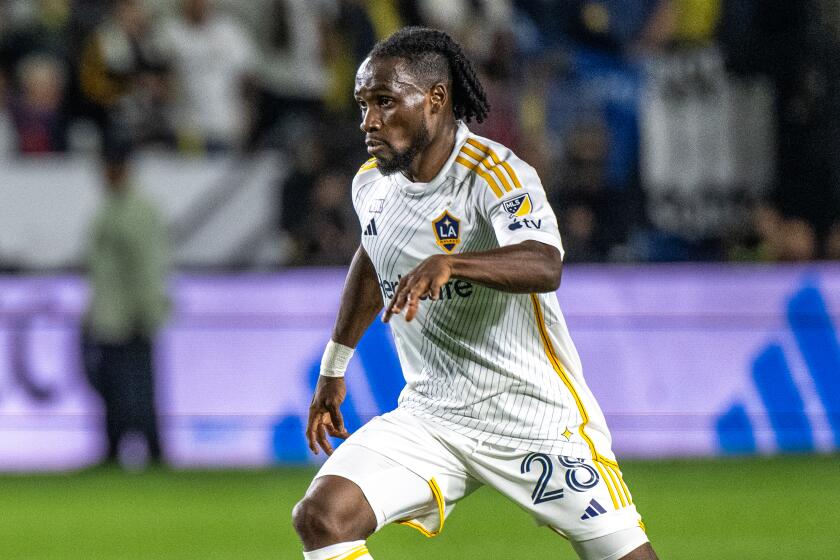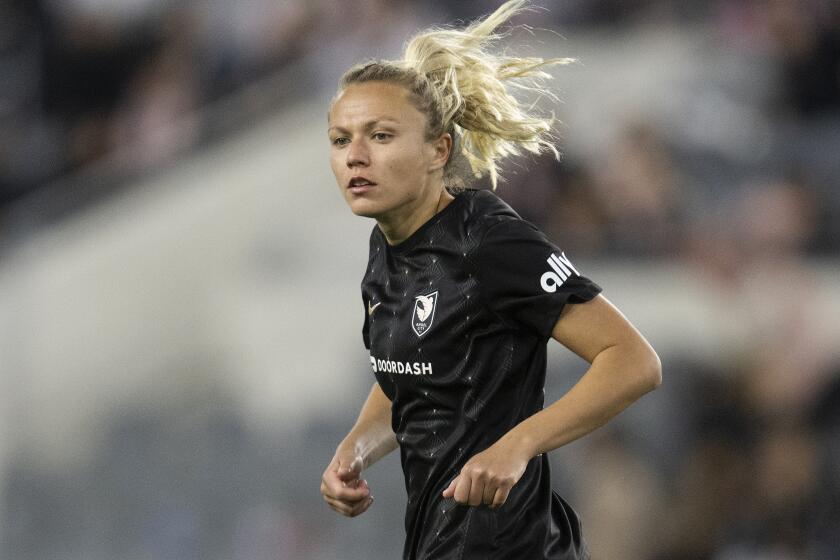MLS steadily builds toward goal of profitability
Clark Hunt’s business card is a little crowded given that he’s chief executive of the NFL’s Kansas City Chiefs and owner of Major League Soccer teams in Dallas and Columbus, Ohio.
“I probably most frequently introduce myself as someone who’s involved with both professional football and professional football,” he says with a grin.
Hunt is also smiling because with attendance, TV revenue, franchise values and expansion fees all at record highs, this is a very good time to be involved with futbol.
Oh, and the NFL isn’t doing too badly either.
“Without doubt this has been the best year in the history of the league,” says MLS Commissioner Don Garber, as the league prepares for Sunday’s championship game between the L.A. Galaxy and Houston Dynamo at a sold-out Home Depot Center.
And at that he may be selling himself short since no U.S. professional sports league has grown as much as MLS over the past five years.
MLS attendance is up 7% to 17,872 per game, better than last season’s NBA and NHL averages, and leaving MLS behind only the NFL and Major League Baseball among U.S.-based pro leagues. And nearly one-third of MLS’ regular-season matches sold out this season.
Expansion fees have increased fourfold since 2007, to $40 million, and will go up again before the league adds a 20th franchise, perhaps as early as 2013.
By the end of next season, 15 of the league’s 19 teams will play in soccer-specific stadiums. Nine were built in the last five years, including Kansas City’s $200-milllion Livestrong Sporting Park, which opened last season.
The league, which once had to pay broadcasters to air its games, recently signed a $30-million, three-year deal with NBC, supplementing agreements it already had with ESPN, Fox and Univision. And the Galaxy, the league’s marquee team, agreed this week to an MLS-record deal with Time Warner Cable worth $55 million over 10 years.
“That’s pretty amazing to think that’s happened in such a short period,” says Hunt, who was captain of a nationally ranked soccer team at Southern Methodist and is now a member of the MLS Board of Governors. “We’ve really become a nation that loves the sport of soccer.”
One thing MLS hasn’t done, however — and this is a big one — is turn a profit.
Even with revenue at an all-time high, fewer than one-third of the league’s teams will make a profit this season. Even the Galaxy, with an estimated value of more than $100 million, will finish in the red after paying more than $12 million in salary to three designated players, David Beckham, Landon Donovan and Robbie Keane.
“Major League Soccer is a business. And at the end of the day, profitability is one way the main business is measured,” Hunt says. “I would just say the needle is pointed in the right direction.
“If you go back 10 years, I’m not sure any of the teams made money. If you go back 10 years, I’m not sure the franchises were worth anything.
“I’m sure [now] there are some franchises that, if they were sold, would command prices similar to what some of the teams trade for in the other four major professional sports. That is definitely a sea change.”
But there are still other choppy waters left to navigate. D.C. United, one of the league’s original members, has been unable to secure funding for a new stadium or for needed upgrades at its current home, the deteriorating RFK Stadium, and may be forced to move.
A long-planned expansion that would put a second team in the New York market, has repeatedly hit snags. And though Garber prefers to sing the praises of the league’s success stories in Portland, Seattle, Vancouver and Philadelphia, four teams — including winning franchises in Columbus and Dallas — are drawing fewer than 14,000 fans a game.
“Any sports league commissioner is going to be focused on how not just to make your good teams great but to make your teams that are struggling better,” says Garber, a former NFL executive. “That’s a part of the sports business. You’re going to have teams that are going to have challenges.”
The league has weathered such challenges before.
When Garber was brought in as MLS’ second commissioner in 1999, he had to arrest a steep drop in attendance and provide some stability — goals he achieved by seeking deep-pocketed investors and pushing the construction of soccer-friendly facilities.
Garber also began developing goals that put long-term growth over short-term returns.
We “are trying to do everything we can to be profitable in every market. But in some cases, owners have decided to make strategic investments which have affected their profitability,” Garber says. “And that’s required in any emerging sports league.”
Much of that investment has gone into luring big-name international stars such as Beckham, Keane, Thierry Henry and Rafael Marquez to MLS. That, too, was a major philosophical change from the early days of the league, when MLS tried to market itself around often-unknown U.S. players.
In recent years, that strategy has paid off handsomely, earning the league attention and credibility overseas that has, in turn, drawn more players and additional investors.
“We feel very good about where we are today,” Garber says. “Our players and our games are more competitive than the hard-core soccer fan gives us credit for. And that’s something that will change over time.”
New faces in the owners’ suites is another sign of MLS’ maturity, with the pool of investors having grown in size and diversity.
Among those who bought MLS teams in the last seven years are Mexican millionaire Jorge Vergara, owner of his country’s most popular soccer club, Chivas de Guadalajara; Stan Kroenke, who also owns teams in the NBA, NHL and NFL; former Walt Disney Studios chief Joe Roth; and former boxing great Oscar De La Hoya, who in 2008 bought a minority share of the Houston Dynamo.
“In the next five years, soccer has the opportunity to be a major player in sports. So that’s where we see our opportunity,” says De La Hoya. “MLS is here to stay. And it’s going to continue to grow. The demand is there. The kids are playing. And we feel that this investment that we’ve made, we’re starting to see the results with the players, with the stadiums, coming up with investors.
“This was one of the best investments I’ve ever made.”







